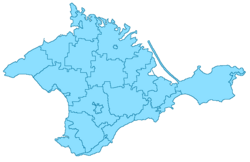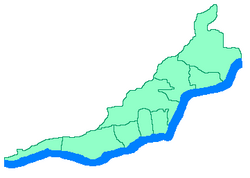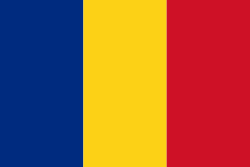Yalta
| Yalta Ялта |
|||
|
|||
 Yalta
|
|||
 Yalta
|
|||
| Coordinates: | |||
| Country | |||
|---|---|---|---|
| Territory | Crimea | ||
| Region | Yalta municipality | ||
| Elevation | 40 m (131 ft) | ||
| Population | |||
| - Total | 80,552 | ||
| Time zone | EET (UTC+2) | ||
| - Summer (DST) | EEST (UTC+3) | ||
| Postal code | 98600 — 98639 | ||
| Area code(s) | +380-654 | ||
| Former name | Yalita (until 15th cent.) | ||
| Website: official website | |||
Yalta (Ukrainian and Russian: Ялта, Crimean Tatar: Yalta) is a city in Crimea, southern Ukraine, on the north coast of the Black Sea. The city is located on the site of an ancient Greek colony, said to have been founded by Greek sailors who were looking for a safe shore (γιαλος - yalos in Greek) on which to land. It is situated on a deep bay facing south towards the Black Sea, surrounded by wooded mountains. It enjoys a warm Mediterranean climate with many vineyards and orchards in the vicinity.
The term "The Greater Yalta" is used to designate a part of the Crimean southern coast spanning from Foros in the west to Gurzuf in the east and including the city of Yalta and multiple adjacent urban settlements (the area of the Greater Yalta is marked dark blue on the map).
Contents |
History
12th-19th centuries
The existence of Yalta was first recorded in the 12th century by an Arab geographer, who described it as a Byzantine port and fishing settlement. It became part of a network of Genoese trading colonies on the Crimean coast in the 14th century, when it was known as Etalita or Galita. Crimea was captured by the Ottoman Empire in 1475, which made it a semi-independent subject territory under the rule of the Crimean Khanate but the southern coast with Yalta was under direct ottoman rule forming the Eyalet of Kefe (Feodosiya). Yalta was annexed by the Russian Empire in 1783, along with the rest of Crimea, sparking the Russo-Turkish War, 1787-1792. Prior to the annexation of the Crimea, the Crimean Greeks were moved to Mariupol in 1778; one of the villages they established nearby is also called Yalta.
In the 19th century, the town became a fashionable resort for the Russian aristocracy and gentry. Leo Tolstoy spent summers there and Anton Chekhov in 1898 bought a house ("Belaya Dacha" - The White Mansion) here, where he lived till 1902; Yalta is the setting for Chekhov's short story, The Lady with the Dog and such prominent play as "The Three Sisters" was written in Yalta. The town was also closely associated with royalty. In 1889 Tsar Alexander III built the Massandra Palace a short distance to the north of Yalta and Nicholas II built the Livadia Palace south-west of the town in 1911.
In the 20th century
During the 20th century Yalta was the principal holiday resort of the Soviet Union. In 1920, Lenin issued a decree "On the Use of Crimea for the Medical Treatment of the Working People" which endorsed the region's transformation from a fairly exclusive resort area into a recreation facility for tired proletarians. Numerous workers' sanatoria were constructed in and around Yalta. There were, in fact, few other places that Soviet citizens could come for a seaside holiday, as foreign travel was forbidden to all but a handful. The Soviet elite also came to Yalta; the Soviet dictator Stalin used the Massandra Palace as his summer residence. NKVD shot all prisoners in city prisons on November 4, 1941.In nearby Livadia Palace,the crimeajewel,having disappeared in the turmoil of the 1917 Russian revolution-before the later nazi invasion of WWII. [1].


The town came to worldwide attention in 1945 when the Yalta Conference between the "Big Three" powers; the Soviet Union, the United States and the United Kingdom – was held at the Livadia Palace.
Modern Yalta
Following the collapse of the Soviet Union in 1991, Yalta has struggled economically. Many of the nouveaux riches started going to other European holiday resorts, now that they had the freedom and money to travel; conversely, the impoverishment of many ex-Soviet citizens meant that they could no longer afford to go to Yalta. The town's transport links have been significantly reduced with the end of almost all passenger traffic by sea. The most exotic way of travelling to Yalta is the Crimean Trolleybus line, which runs from Simferopol via Alushta to Yalta. In recent years, Yalta has staged a recovery, as economic conditions have improved and tourists have returned. It is still almost entirely frequented by Russian and Ukrainian tourists, with the constantly growing stream of visitors from Western Europe, mostly from Germany.
Today, Yalta has a beautiful embankment along the Black Sea. People can be seen strolling there all seasons of the year, and it also serves as a place to gather and talk. There are several beaches along the embankment where people relax and go swimming. Some hardy souls even do this in the winter. This embankment is also the site of several hotels and amusement-park-like rides. In addition, the city has several movie theaters, and many restaurants and cafés, as well as a large open-air market.
Main sights
Famous attractions within or near Yalta are:
- Yalta's Sea Promenade (Naberezhnaya), housing many attractions and being recently renovated (2003-2004);
- Armenian Church, built by V. Surenyants;
- A Roman Catholic Church built by N. Krasnov, a famous Russian architect
- Yalta's Cablecar, taking visitors to the Darsan hill, from which one can see Yalta's shoreline;
- Renovated Hotel Taurica, the first hotel in the former Russian Empire with elevators;
- Alexander Nevsky Cathedral, constructed by the architect Krasnov, which also constructed the Livadia Palace and the architect P. Terebenyov;
- Former main building of the Ministry of Defence hotel, built in the style of a Gothic castle;
- Palace of Bukhara Emir;
- Yalta's Zoo;
- Yalta's Aquarium, housing small dolphins;
- Park-museum Polyana Skazok (Glade of Fairytales);
- House-museum of Anton Chekhov;
- House-museum of Lesya Ukrainka;
- House with Caryatids, where the composer A. Spendiarov lived
Moreover, Yalta's suburbs house:
- Nikitsky Botanical Garden (Nikita)
- Livadia Palace (Livadiya)
- Organ hall in Livadiya
- Massandra Palace (Massandra)
- Massandra Winery and Vaults
- International children's centre of Artek(Gurzuf)
- Ai-Petri Mountain (1233 metres high, with a cable car traveling to and from the mountain)
- Vorontsov Palace (Alupka)
- Swallow's Nest castle near Gaspra.
Climate
As Yalta lies to the south of the Crimean Mountains and within an amphitheatre of hills, the climate is very mild. In February, the average temperature reaches 4°C. Snow is rarely seen and the city's thin layers of snow thaw quickly. In July, the average temperature reaches 24°C. The sun shines approximately 2,250 hours per year. Since the city is located on the shore of the Black Sea, the weather rarely becomes extremely hot due to the cool sea breezes. The average year temperature for Yalta is + 13 C.
Demographics
As of the Ukrainian Census conducted on January 1, 2001, the population of Yalta is 80,500. It is slowly lessening due to the aging of the population - the process evolving in all Europe. The nationality structure of Yalta is: Russians — 48.3%, Ukrainians 25.7%, Crimean Tatars — 21 %, Jews — 0.8%, belarussians — 2%, and many other minority groups. The absolutely predominant language in the streets of the city is Russian. This total number doesn't comprise the population of neighbouring villages and small towns. The metropolitan area population is about 125 000.
Twin cities
Yalta is twinned with the following cities:
 Baden-Baden, Germany
Baden-Baden, Germany Batumi, Georgia
Batumi, Georgia Galaţi, Romania
Galaţi, Romania Margate, United Kingdom
Margate, United Kingdom Nice, France
Nice, France Pärnu, Estonia
Pärnu, Estonia Pozzuoli, Italy
Pozzuoli, Italy Rijeka, Croatia
Rijeka, Croatia Santa Barbara, United States
Santa Barbara, United States Sanya, China
Sanya, China Ohrid, Republic of Macedonia
Ohrid, Republic of Macedonia
External links
- Yalta: The Big Yalta(Ru)
- Yalta Сity portal (English) (Spanish) (Russian)
- Verkhovna Rada website — Statistics for Yalta
- Yalta City and Yalta Zoo photoalbum
- Yalta attractions (English)
 Wikimedia Commons — Media on Yalta
Wikimedia Commons — Media on Yalta
|
|||||||||||||||||||||

